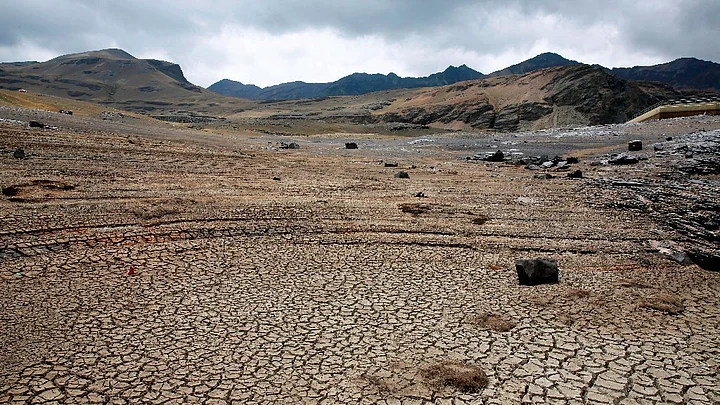The World Meteorological Organisation’s annual report on climate change in 2016 summarises this man-made crisis ominously: “We are now in truly uncharted territory.”
The UN-based agency has notified that extreme climate and weather conditions are continuing well into 2017, after 2016 topped global temperature charts and broke other climate records. Even without El Niño, the current partially responsible for 2016’s record weather, land and sea temperatures continue to rise, sea levels keep increasing and the arctic sea ice level continues to dwindle down further.
This year’s February saw 11, 743 temperature records being broken in the US alone. The Arctic region has witnessed the polar equivalent of a heatwave three times already at the height of its winter, bringing it close to melting point. Closer to home, Mumbai saw temperatures between 36-38 degree Celsius in the second week of February.
Key Findings
This report confirms that the year 2016 was the warmest on record – a remarkable 1.1°C above the pre-industrial period, which is 0.06°C above the previous record set in 2015. This increase in global temperature is consistent with other changes occurring in the climate system. Globally averaged sea surface temperatures were also the warmest on record, global sea levels continued to rise, and Arctic sea ice extent was well below average for most of the year. With levels of carbon dioxide in the atmosphere consistently breaking new records, the influence of human activities on the climate system has become more and more evident.Petteri Taalas, Secretary-General, WMO
The powerful El Niño event boosted warming in 2016, on top of long-term climate change caused by greenhouse gas emissions. Global sea levels rose very strongly due to El Niño by almost 15 mm, while the average rise is recorded at 3 mm.
Global sea ice extent dropped more than 4 million square kilometres below average in November, completely unprecedented for peak freezing season. High ocean temperatures contributed to “significant coral bleaching and mortality was reported in many tropical waters, with important impacts on marine food chains, ecosystems and fisheries.” Carbon dioxide levels in the atmosphere reached the toxic benchmark of 400 parts per millions in 2015 and will not fall below that level for many generations to come because of the long-lasting nature of CO2.
Extreme Events of 2016: India Edition
As temperatures soared in 2016, Himalayan glaciers saw a significant amount of melting. According to The International Centre for Integrated Mountain Development, 54,000 individual glaciers in the Hindukush Himalayan region are shrinking and retreating.
Latur in Maharashtra suffered from the second consecutive year of acute drought in 2016’s summer months. Thousands of litres of water had to be sent to the district in “water trains” to provide for 12 lakh parched citizens. When monsoons finally came, flash floods ruined agricultural produce in bulk in Latur, Nanded and Beed in Maharashtra and flooded the Ganges basin in parts of Bihar and Uttar Pradesh.
Vardah became the most severe cyclone since 1994 to make landfall, with wind speeds as high as 120 kmph at Tamil Nadu, uprooting over 4,000 trees, leaving hundreds homeless and killing eight persons.
A Rajya Sabha standing committee report in December 2016 expressed grave concern at the increase in fires in the country. The report stated that while there were 15,937 forest fires in 2015, the number went up to 24,817 in 2016. Other times, MPs have testified to the tangible, documented effects of climate change in India in 2016 when they reported that 1.8 million tonnes of milk is lost annually due to weather variability, food grain production has fallen from 265.04 million tonnes in 2014 to 252.12 million tonnes in 2016, and new species of insects have taken to common crops like tomato, leading to food shortages.
In a new report released for World Water Day on 22 March, data suggests that 63 million people living in rural areas of India don’t have access to clean drinking water. With soaring temperatures and decreasing groundwater levels, people – mostly women – have to travel scores of kilometres to fetch drinking water. Due to three consecutive drought cycles in Bundelkhand in north-central India, for instance, millions of people have been forced into chronic hunger and poverty.
Extreme Events of 2016: World Edition
- Parts of East Africa declared in famine for the first time since World War II due to crop failure when rainfall fell by 60% below average; almost 20 million people in need of aid.
- Flooding displaced hundreds of thousands of people and killed more than a hundred in south-east Asia during monsoon, while flooding after a devastating drought in Tasmania destroyed 2,000 homes, rendered 5,000 people homeless and killed 22.
- We crossed the toxic benchmark of 400 parts per million of carbon dioxide in the atmosphere.
- The wettest ever winter was recorded in Scotland and China had its wettest year with UK not far behind as both countries witnessed flash flooding.
- Extreme temperatures saw records fall: Svalbard in the Arctic was 6.5°C warmer over the year than the average between 1961 and 1990
- Devastating and record-breaking wildfires occurred in Tasmania, Canada and California.
- Hurricane Mathew, a category-4 hurricane, was the strongest to make landfall in the Caribbean since 1963.
More Vikaas, More Emissions?
India occupies a unique position in this quickly escalating ecological crises. It is the third-largest producer of greenhouse gases after the US and China. It also lies in the top 38% of countries most vulnerable to climate change, and least ready to adapt.
Under the United Nations Paris Agreement, which it ratified in 2016, India has committed to generating at least 40 percent of its electricity from renewable sources and decreasing carbon emission related to its GDP by 33 to 35 percent by 2030. With an ever-growing population and high levels of pollution in its metropolitan cities, India’s future rests on documents like the Paris Agreement.
